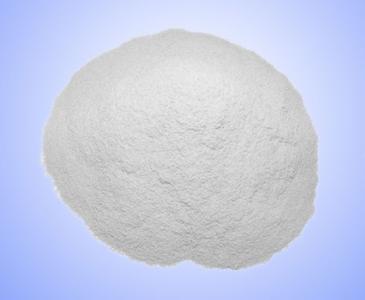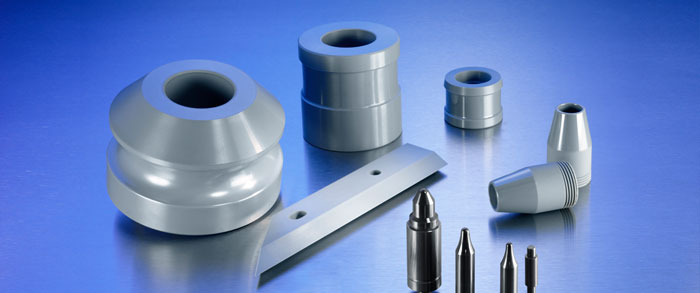1. Brief introduction of silicon nitride ceramics
Silicon nitride (Si3N4) is a covalently bonded compound that has two crystal types, α-Si3N4 and β-Si3N4. α-Si3N4 is acicular crystal, β-Si3N4 is granular crystal, both belong to hexagonal crystal system.
White or off-white α-Si3N4 can be obtained by nitrifying high purity Si at 1200~1300℃, and nitrated at 1450℃ chemical temperature so β-SI3N4 can be obtained.

Silicon nitride powder
2. Manufacturing technology of silicon nitride ceramics
Si3N4 is a exceedingly difficult material to sinter, so it is exceedingly difficult to achieve dense sintering like oxide ceramics. The firing of Si3N4 ceramics the junction method can be divided into two categories: nitriding reaction sintering method and compact sintering method using admixtures. The latter type of sintering is required for high quality powder raw materials, so the performance of Si3N4 powder has relatively high requirements.
(1) Preparation of Si3N4 powder.
① Direct nitriding of Si
The silicon(Si) powder with certain fineness and purity is heated by nitrogen in the furnace. General silicon powder contains Fe, SiO2, Ca and other miscellaneous the total amount of these impurities is required to be less than 2%.
Si3N4 powder is generally a mixture of α-Si3N4 and β-Si3N4 and the high purity of silicon(Si)powder is at temperature of 1200~ ~1300℃ α-Si3N4 is obtained and at when temperature is at 1450℃, the β-Si3N4 is obtained.
Exothermic reaction of silicon(Si)powder nitrogen, its rise temperature system should be well controlled during nitriding. Otherwise the temperature may exceed due to exothermic heat. The required nitriding temperature increases the β-Si3N4 phase: In addition, beyond the melting point of silicon(Si) (1400℃), the fusion group of silicon powder will hinder the continuous nitrification. Therefore, the purity of nitrogen, fineness of Si powder and ammonification temperature are all important factors affecting to the quality of Si3N4 powder.
This is direct nitriding method of silicon powder, the product agglomerates, coarse particles, must be re-crushed before to use, the process is easy to mix and the quality affects the high temperature performance of the product.
②SiO2 reduction nitriding method
SiO2 (quartz powder) and C (carbon) are raw materials with high purity. The Si3N4 powder generated has high purity, the particle size has reaction heat absorption, and faster nitridation rate than Si powder.
This reaction is more complicated. In addition to Si3N4, there are Si2N2O and unreacted SiO2 mixture, so the reaction temperature must be controlled such as high degree to avoid SiC formation. It is necessary to take measures to control the morphology of powder because it is mainly gas reaction and easy to produce fibrous materials.
It is proved that Si3N4 powder prepared by SiO2 and carbon reduction nitrification has high content and higher bending strength after sintering, This method can be used to prepare high-performance powder. However, SiO2 is not easy to reduce nitridation, which is a serious problem. If there is a small amount of SiO2 in the synthesized Si3N4 powder, SiO2 will form low eutectic with metal impurities at high temperature during sintering, which will seriously affect the high-temperature performance of the material.
③Thermal decomposition of imines and amines
The method is also known as SiCl4 liquid method. SiCl4 reacts with excess anhydrous ammonia gas in 0℃ dried ethane to form iminoids Silicon, amino silicon and NH4CI precipitation. NH4CI can be vacuum-heated and decomposed at 1200~1350℃ in N2, and can also be used as liquid ammonia is removed by multiple washing. Si3N4 powder can be obtained by heating it in a high temperature inert gas.
Si or SiH4 and NH3 by chemical vapor deposition (CVD) method
When SiCl4 volatilized gas or SiH4 is vaporized at 1000~1200℃ and directly reacts with NH3 to form amorphous Si3N4 , and then heat treatment to obtain high purity, ultra-SI3N4 powder, the two methods are highly reactive, complex equipment, difficult to control. The product is generally high purity ultrafine powder, but the cost is high low yield, often containing ions harmful to densification.
(2) Reaction of Sintered Nitride
Reactive sintering silicon nitride means heating silicon powder in a nitriding furnace after it is formed according to the shape requirements of the product.
The nitrized product is a mixture of phase and phase, and the product size is basically the same as the billet size, that is, the reverse
The volume of billet should be basically unchanged before and after. This is a characteristic of this process. The product density of this process depends mainly on the shaping
Blank density, the general product contains about 20% of the pores, so the density is not high, not strong. Because this process can accurately produce products with complex shapes, expensive machining is not required. Therefore, reactive sintering silicon nitride has been widely used in industry at present.
At present, this method is commonly used at manufacture silicon nitride ceramics in industries. The technological process is as follows:
Silicon powder - one grinding - one forming - one green nitriding - one repair - one ammonification sintering - one grinding processing - one finished product
Specific process is: first silicon powder grinding, with general forming method of ceramic material (such as grouting, extrusion, dry, cold isostatic pressing, injection pressure, etc.), made into the required shape of the blank, then preliminary under the temperature is farlower than the melting point of silicon nitride, to obtain a certain intensity, and then in the machine tool, its processing to the final product size, formal nitride again, until completely nitriding silicon powder in the process . After cooling, remove to obtain the required silicon nitride components. In general, the parts do not need to be milled.
(3) Hot pressed Silicon nitride (HPSN)
Generally, the density of reactive sintering silicon nitride can only reach 2~ 2.7g /cm3, which requires high density and strength, so heat is needed
Pressure sintering preparation process. The density of hot pressing sintering can reach about 3.2g /cm3.
Hot pressing process requires α-si3n4 content of > 90% fine powder, adding appropriate additives to prevent oxidation, additives
MgO, Y2O3 and Al2O3 are firstly pressed into the steel mold, and the forming pressure is generally 50MPa, and then the grain is fed into the hot pressing furnace. The hot pressing temperature is 1700~1800℃, and the pressure is 20~30MPa in a protective atmosphere. Heat preservation pressure 30~120 min. After hot - pressed products, according to the need for grinding processing.
3 Properties and applications of silicon nitride ceramics
Silicon nitride as a high - temperature engineering materials and remarkable. Silicon nitride ceramics have a range of properties, namely light weight density 3. 19g/cm3), hard (Vickers hardness ~ 19GPa), high strength (elastic modulus ~ 300GPa), small coefficient of thermal expansion (about 3×10-6/℃).
The high-temperature creep resistance of Si3N4 decreases, especially after adding an appropriate amount of SiC, the creep resistance of Si3N4 increases significantly.
The oxidation resistance of Si3N4 is very good, and it can resist oxidation to 1400℃, and the actual use temperature is up to 1200℃.
Si3N4 has good corrosion resistance and can withstand the erosion of most acids, but not concentrated NaOH and HF.
The friction coefficient of Si3N4 is small, only 0.1, which is similar to the metal surface for refueling.
Due to its excellent properties, silicon nitride ceramics have been widely used in many industrial fields and have many potential uses.
It is applied to rotor, stator and vortex tube of gas turbine in ceramic engine with high temperature and wear resistance. Without water-cooling ceramic
Spark plug, piston hood, cylinder liner, auxiliary combustion chamber and parts of piston - turbine combined aeroengine.
It is used in metallurgy and thermal processing industry for its good thermal shock resistance, corrosion resistance, low coefficient of friction and small coefficient of thermal expansion, It is widely used for temperature measuring thermo-couple sleeve, casting mold, crucible, muff furnace chamber, combustion nozzle, surface heating fixture, furnace lining of aluminum smelting furnace, liquid aluminum tube, lining of aluminum materials, lining of aluminum electrolytic cell, heat radiation tube, transfer roller, high temperature blower and valve, etc. In the steel industry, it is used as a shunt ring on the horizontal continuous caster for steelmaking. Crucible used for drawing monocrystalline silicon in the electronics industry.
It is widely used in the chemical industry as ball valve, sealing ring, filter and heat exchanger parts, etc.
Good wear resistance, high strength, low friction coefficient characteristics, it is widely used in the mechanical industry for bearing ball rolling, Column, ball bearing ring, high temperature bolt, working mold, plunger pump, sealing material, etc.
In addition, it is used in electronics, military and nuclear industries, such as switch circuit substrates, film capacitors, high temperature insulators, radars, missile nozzles, gun barrel liners, supports for nuclear reactors, isolators and carriers of nuclear fissile material.

Silicon nitride ceramic parts
Declaration: This article is provided by CERADIR™ users or obtained from Internet, the content does not represent the position of CERADIR™. We are not responsible for the authenticity/accuracy of the article, especially the effects of the products concerned. This article is for study only, it does not constitute any investment or application advice. For reprinting, please contact the original author. If it involves the copyright and/or other issues, please contact us and we will deal with it asap! CERADIR™ has the interpretation of this declaration.







